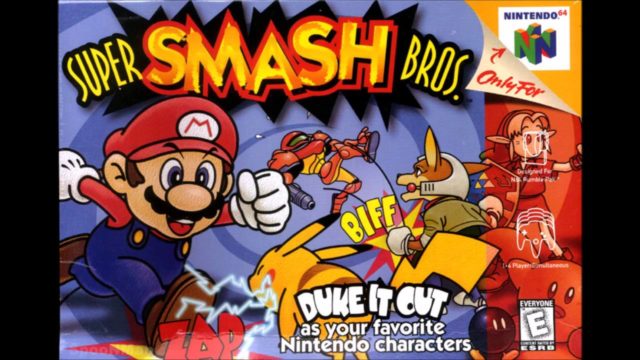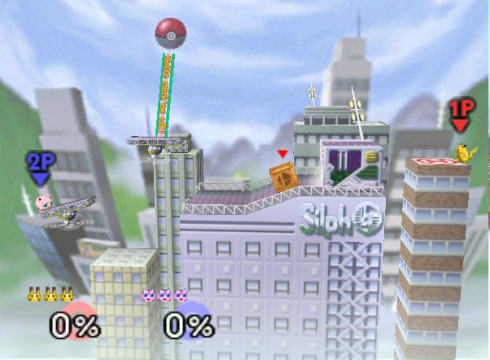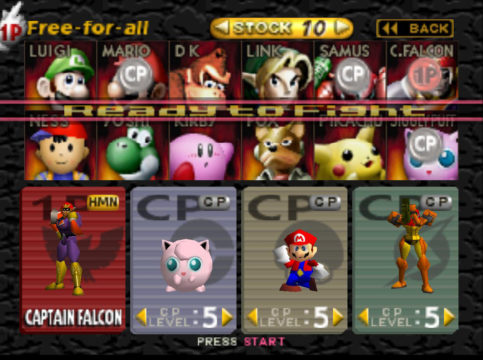
Twenty years ago today, Super Smash Bros. released on Nintendo 64 in Japan. When Masahiro Sakurai first pitched the concept, the game’s Nintendo icons were merely intended as placeholders; Sakurai never believed Nintendo would embrace the concept of a fighting game featuring its characters. After all, this was the same Nintendo that, only a few years prior, censored Mortal Kombat on the Super Nintendo. The game would prove a tough sell to the company, but the title quickly found a fanbase, going on to become one of the biggest franchises in Nintendo’s entire stable. Compared to Super Smash Bros. Ultimate, the N64 original might seem fairly quaint, but it has created an endearing legacy that lasts to this day.
With its 12 playable characters and nine stages, younger fans, in particular, might find the roster for Super Smash Bros. fairly tame. At first glance, the game’s eight initial fighters seem to well represent the company’s biggest franchises and little else. Looking back at the time of the game’s release, however, provides some interesting insights into each of the game’s inclusions, hinting at a bigger and bolder future both for the franchise, and Nintendo in general.

In retrospect, it’s easy to see why Super Smash Bros. found success right off the bat. The title released at the perfect time for Nintendo. The dying months of 1998 provided the company with a pair of monumental successes: a global release for The Legend of Zelda: Ocarina of Time and the North American debut of Pokémon Red and Blue. Having Link and Pikachu as two of the game’s eight starting playable characters so shortly after these successes likely bolstered the potential audience for Super Smash Bros. The game also marked the Pokémon franchise’s debut on a Nintendo home console, helping to firmly solidify the series’ standing as one of Nintendo’s premier offerings.
Of the game’s initial eight fighters, perhaps none was more surprising than the inclusion of Samus Aran. Though Super Metroid had released to universal acclaim in 1994, the character hadn’t had a starring role in five years. Nintendo had shopped around the idea of a new game starring Samus, but the character had been seemingly forgotten. One year after the release of Super Smash Bros., development would begin on Metroid Prime. There has never been any official link between these two events, but many fans doubtlessly became aware of the franchise for the first time thanks to Smash. It certainly wouldn’t be the last time a Super Smash Bros. game provided an existing franchise with a much bigger spotlight.

The game’s unlockable fighters would provide more hints of things to come. Though the term wouldn’t come into use until 2018, Luigi gave the roster its first Echo Fighter (in a way), mirroring the moves of his brother Mario. Like Samus, Ness was a fairly intriguing choice for a playable character, with his lone prior appearance arriving in the same year as Super Metroid. Ness has been a staple of every Smash Bros. game since, but he still hasn’t found the same level of success of Samus. Still, his inclusion would foreshadow much stranger future fighters in the franchise, such as the Ice Climbers or Mr. Game and Watch.
Perhaps one of the game’s most notable inclusions, however, is its unlockable Mushroom Kingdom stage. The 1999 release of Super Smash Bros. came just over 15 years after the debut of the Famicom in Japan. At this point, the video game industry was hardly known for looking back, always focusing instead on the next big thing. The inclusion of a stage heavily inspired by the 8-bit beginnings of Mario was, arguably, a major moment for gaming. While these types of old-school references are common today, during the N64 era, they were relatively unheard of. That simple instance of looking back and embracing the past, rather than constantly looking forward, may have been a catalyst for so many of the retro-inspired games and visuals that have become a staple of the video game industry in the modern era.
For all the things the original Super Smash Bros. has given us, nothing could be more important than its gameplay. From a personal standpoint, the title released when I was in eighth grade, inspiring after school battles and late night sessions during sleepovers. Over its various incarnations, the franchise has seen a plethora of changes to make things work better and run smoother, but the frantic, four-player core of the game remains the same as it did back then. Twenty years after its debut, audiences continue to enjoy the franchise in much the same way (though portability does make it more convenient!). It’s easy to look back and see the original Super Smash Bros. as antiquated, but the game truly remains every bit as endearing today as it was back then.




 ShareThis
ShareThis





